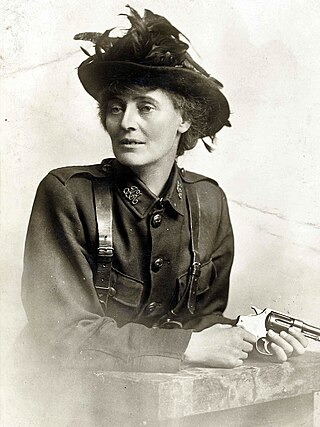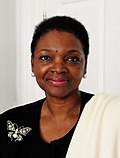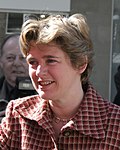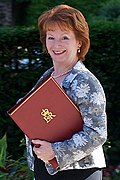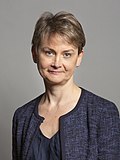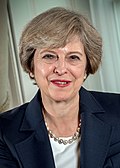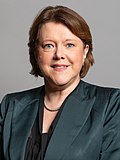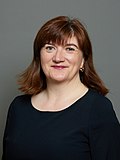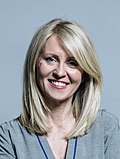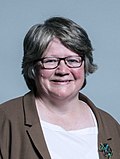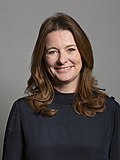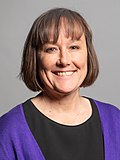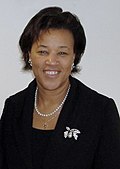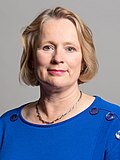Top Qs
Timeline
Chat
Perspective
Women in the House of Commons of the United Kingdom
Females in the British House of Commons From Wikipedia, the free encyclopedia
Remove ads
The representation of women in the House of Commons of the United Kingdom has been an issue in the politics of the United Kingdom at numerous points in the 20th and 21st centuries. Originally debate centred on whether women should be allowed to vote and stand for election as Members of Parliament. The Parliament (Qualification of Women) Act 1918 gave women over 21 the right to stand for election as a Member of Parliament. The United Kingdom has had three female Prime Ministers: Margaret Thatcher (1979–1990), Theresa May (2016–2019), and Liz Truss (2022). The publication of the book Women in the House by Elizabeth Vallance in 1979 highlighted the under-representation of women in Parliament.[1] In more modern times concerns about the under-representation of women led the Labour Party to introduce and, decades later, abandon all-women short lists, something which was later held to breach discrimination laws.

Between 1918 and 2024, a total of 693 women have been elected as Members of the House of Commons. As of July 2024 there are 263 women in the House of Commons, the highest ever.[2] This is an all-time high at 40%. The previous number was 220, set in 2019, which accounted for 35% of members elected or re-elected that year.[3] Additionally, at the 2024 general election the most female Labour MPs were elected or re-elected (190 women in total) – another instance in Labour's history that this has happened, after 119 in 2017. The female member of Parliament with the longest period of continuous service is informally known as the Mother of the House, who is Diane Abbott, following the 2024 election.[4]
Remove ads
Suffrage
In 1832 Henry Hunt became the first MP to raise the issue of women's suffrage in the House of Commons,[5] followed in 1867 by John Stuart Mill. Following this attempts were made to widen the franchise in every Parliament.[6]
Women gained the right to vote with the passing of the Representation of the People Act 1918 after World War I. This gave the vote to women over the age of 30. However, the Speakers Conference which was charged with looking into giving women the vote did not have as its terms of reference, consideration to women standing as candidates for Parliament. However, Sir Herbert Samuel, the former Liberal Home Secretary, moved a separate motion on 23 October 1918 to allow women to be eligible as Members of Parliament. The vote was passed by 274 to 25 and the government rushed through a bill to make it law in time for the 1918 general election.[7] This bill did not specify any age restriction, unlike the voting bill.[8] This later led to a number of incidents of women under the age of 30, who were not allowed to vote, standing for Parliament, notably the 27-year-old Liberal Ursula Williams standing in 1923.[9]
Remove ads
Landmarks and records
Summarize
Perspective
Political firsts for women in House of Commons
- 1918: Women able to stand for Parliament.
- 1918: First woman elected to Parliament (Constance Markievicz). However, as a member of Sinn Féin, she did not take her seat.[10] Markievicz also became the only woman to represent an Irish constituency in Parliament until 1922 and the first female member who, before the election, chose to become a Catholic.[11]
- 1919: Member of Parliament to take her seat (Nancy Astor) – for Coalition Conservatives
- 1921: British-born member to take her seat (Margaret Wintringham) – Liberal Party
- 1923: Disabled woman (Mabel Philipson) – Conservative Party. She had no vision in one eye.
- 1924: Minister (Margaret Bondfield) – for Labour Party
- 1926: Member to represent more than one constituency in non-consecutive terms (Margaret Bondfield) – Labour Party
- 1929: Cabinet minister and privy counsellor (Margaret Bondfield)
- 1929: Female Baby of the House (Jennie Lee) – Labour Party
- 1929: Independent member elected (Eleanor Rathbone)
- 1929: Non-Christian elected (Marion Phillips) – Labour Party
- 1929: Shortest-serving member (Ruth Dalton) – Labour Party; equalled in 1974 by Margo MacDonald – SNP
- 1931: Member to cross the floor (Cynthia Mosley) – from Labour to New Party
- 1931: Member to die in office and oldest woman elected (Ethel Bentham) – Labour Party
- 1938: Resignation from the House, i.e. appointment to a stewardship (The Duchess of Atholl) – Unionist Party
- 1943: Wheelchair user (Lady Apsley) – Conservative Party
- 1948: Chair of Committee of Whole House (Florence Paton) – Labour Party
- 1948: British-born Catholic (Alice Cullen) – Labour Party
- 1953: Member from Northern Ireland; first Irishwoman to take her seat (Patricia Ford) – Ulster Unionist Party
- 1965: Parliamentary Whip (Harriet Slater) – Labour Party
- 1969: Irish republican non-abstentionist (Bernadette Devlin McAliskey) – Unity
- 1970: Deputy speaker (Betty Harvie Anderson) – Conservative Party
- 1974: Youngest woman to leave the House (Bernadette Devlin McAliskey) – Independent Socialist
- 1975: Leader of the Opposition (Margaret Thatcher)
- 1976: Member outed as LGBT (Maureen Colquhoun) – Labour Party
- 1979: Prime Minister (Margaret Thatcher) who led the Conservative Party from 1975 to 1990.
- 1987: Member from ethnic or racial minorities (Diane Abbott) – Labour Party
- 1992: Speaker of the House of Commons (Betty Boothroyd) – Labour Party. As of 2025 she remains the only female to hold the office of House Speaker.
- 1997: Full-time Minister for Women (Joan Ruddock) – Labour Party
- 1997: Member who came out as LGBT in office (Angela Eagle) – Labour Party
- 1998: Chief Whip (Ann Taylor)[3] – Labour Party
- 2010: LGBT member elected (Margot James) – Conservative Party
- 2010: Minor party members elected (Caroline Lucas – Green Party of England and Wales; Naomi Long – Alliance Party of Northern Ireland)
- 2015: Youngest woman elected (Mhairi Black) – SNP
- 2016: Cabinet minister to come out in office (Justine Greening)[12] – Conservative Party
- 2016: Member to be assassinated (Jo Cox) – Labour Party. She became also the first Labour MP to die as a crime victim.
- 2017: Oldest woman to be re-elected (Ann Clwyd) - Labour Party
- 2019: Ethnic minority female holder of a Great Office of State (Priti Patel) – Conservative Party
- 2019: Non-Christian by choice of conversion elected (Charlotte Nichols),[13] and hijab-wearing member (Apsana Begum) – Labour Party
- 2019: Oldest woman to leave the House (Ann Clwyd) – Labour Party
- 2019: Member to be recalled by a successful petition (Fiona Onasanya) – Independent, originally elected as Labour
- 2022: Youngest, shortest-serving Prime Minister (Liz Truss) and female Deputy Prime Minister (Thérèse Coffey) – Conservative Party
- 2022: Member to vacate her seat for an actual paid office under the Crown (Rosie Cooper) – Labour Party
- 2024: Former prime minister to lose re-election (Liz Truss) – Conservative Party
- 2024: First female Chancellor of the Exchequer (Rachel Reeves) – Labour Party
- 2024: Ethnic minority deputy speaker (Nus Ghani) – Conservative Party
- 2024: Ethnic minority leader of the opposition and also her party's youngest female parliamentary leader (Kemi Badenoch) – Conservative Party
Records
Margaret Beckett has been the longest serving female MP in the history of the House of Commons. She was an MP for Lincoln from 10 October 1974 until 7 April 1979, and served as MP for Derby South from 9 June 1983 until 30 May 2024.
Harriet Harman has been the longest continuously serving female MP in the history of the House of Commons. She was MP for Peckham from 28 October 1982 until 1 May 1997, and served as MP for Camberwell and Peckham from 1 May 1997 to 30 May 2024. On 13 June 2017 Harman was dubbed "Mother of the House" by Prime Minister Theresa May, in recognition of her status as longest continuously serving woman MP (though she was not the longest serving MP overall, and would therefore not gain any official duties).
Female MPs with more than 25 years' service
As of 2024, there are 36 women (out of a total of 693) who have served 25 years or more service in the House of Commons, either continuously or cumulatively.
Remove ads
Current representation
Summarize
Perspective
As of May 2025, there are 264 female MPs in the House of Commons.
In February 2018 the Electoral Reform Society reported that hundreds of seats were being effectively 'reserved' by men, holding back women's representation. Their report states that 170 seats have been held by men first elected in 2005 or before – with few opportunities for women to take those seats or selections. Broadly speaking, the longer an MP has been in Parliament, the more likely they are to be male.[16][17]
Current female Cabinet members (Labour Party)
- Angela Rayner – Deputy Prime Minister and Secretary of State for Housing, Communities and Local Government
- Bridget Phillipson – Secretary of State for Education
- Lucy Powell – Leader of the House of Commons and Lord President of the Council
- Lisa Nandy – Secretary of State for Culture, Media and Sport
- Rachel Reeves – Chancellor of the Exchequer
- Yvette Cooper – Secretary of State for the Home Department
- Shabana Mahmood – Lord Chancellor and Secretary of State for Justice
- The Baroness Smith of Basildon – Leader of the House of Lords and Lord Privy Seal
- Liz Kendall – Secretary of State for Work and Pensions
- Heidi Alexander – Secretary of State for Transport
- Jo Stevens – Secretary of State for Wales
Remove ads
Historic representation
Summarize
Perspective
2024 election
Female Cabinet members appointed after the 2024 election
- Louise Haigh – Secretary of State for Transport
2019 election
In the 2019 general election, 220 women were elected, making up 34% of the House of Commons, up from 208 and 32% before the election.[18]
Female Cabinet members appointed after the 2019 election
- Suella Braverman[af] - Attorney General for England and Wales (2020–22)[ag]/Secretary of State for the Home Department (2022, 2022–23)
- Thérèse Coffey – Secretary of State for Work and Pensions (2019–22)/Health and Social Care & Deputy Prime Minister (2022)/Environment, Food and Rural Affairs (2022–23)
- Michelle Donelan – Secretary of State for Education (2022)/Digital, Culture, Media and Sport (2022–23)/Science, Innovation and Technology[ah] (2023–24)
- Nadine Dorries – Secretary of State for Digital, Culture, Media and Sport
- Baroness Evans of Bowes Park – Leader of the House of Lords
- Amanda Milling – Minister Without Portfolio
- Priti Patel – Secretary of State for the Home Department (2019–22)
- Chloe Smith – Secretary of State for Work and Pensions (2022)/Science, Innovation and Technology (2023)
- Anne-Marie Trevelyan – Secretary of State for International Development (2020)/International Trade and President of the Board of Trade (2021–22)/Transport (2022)
- Liz Truss – Secretary of State for Foreign, Commonwealth and Developmental Affairs (2021–22)/Prime Minister (2022)
- Kemi Badenoch – Secretary of State for International Trade (2022–23)/Business and Trade (2023–24)/President of the Board of Trade
- Gillian Keegan – Secretary of State for Education
- Penny Mordaunt – Leader of the House of Commons/Lord President of the Council
- Lucy Frazer – Secretary of State for Culture, Media and Sport
- Claire Coutinho – Secretary of State for Energy Security and Net Zero (2023–24)
- Victoria Atkins – Secretary of State for Health and Social Care (2023–24)
2017 election
In the 2017 general election, 208 women were elected, making up 32% of the House of Commons, up from 191 and 29% before the election.[3]
Female Cabinet members appointed after the 2017 election
- Theresa May – Prime Minister
- Liz Truss – Secretary of State for International Trade/President of the Board of Trade
- Thérèse Coffey – Secretary of State for Work and Pensions (2019)
- Baroness Evans of Bowes Park – Leader of the House of Lords
- Penny Mordaunt – Secretary of State for Defence
- Karen Bradley – Secretary of State for Northern Ireland
- Andrea Leadsom – Secretary of State for Business, Energy and Industrial Strategy
- Priti Patel – Secretary of State for the Home Department
- Theresa Villiers – Secretary of State for Environment, Food and Rural Affairs
- Nicky Morgan – Secretary of State for Digital, Culture, Media and Sport
- Esther McVey – Secretary of State for Work and Pensions (2018)
- Amber Rudd – Secretary of State for Work and Pensions (2018–19)
2015 election
In the 2015 general election, 191 women were elected, making up 29% of the House of Commons, up from 141 and 23% before the election.[19]
Female Cabinet members appointed after the 2015 election
- Theresa May – Secretary of State for the Home Department
- Justine Greening – Secretary of State for International Development
- Nicky Morgan – Secretary of State for Education and Minister for Women and Equalities
- Baroness Stowell of Beeston – Leader of the House of Lords
- Theresa Villiers – Secretary of State for Northern Ireland
- Liz Truss – Secretary of State for Environment, Food and Rural Affairs (2014–16)/Justice (2016–17)
- Amber Rudd – Secretary of State for Energy and Climate Change
2010 election
As elected in the 2010 general election.
Female Cabinet members appointed after the 2010 election
- Theresa May – Secretary of State for the Home Department
- Caroline Spelman – Secretary of State for Environment, Food and Rural Affairs
- Cheryl Gillan – Secretary of State for Wales
- Baroness Warsi – Minister without Portfolio
A total of 46 female ministers have held Cabinet positions since the first, Margaret Bondfield, in 1929. Tony Blair's 1997 Cabinet had five women and was the first to include more than two female ministers at one time. The highest number of concurrent women Cabinet ministers under Tony Blair was eight (36 per cent), then a record from May 2006 to May 2007. Other women have attended Cabinet without being full members, including Caroline Flint, Anna Soubry and Caroline Nokes. Some who have attended Cabinet have subsequently, or previously been full Cabinet ministers, including Tessa Jowell, Liz Truss and Andrea Leadsom.
All-women shortlists
All-women shortlists are a method of affirmative action which has been used by the Labour Party to increase the representation of women in Parliament. As of 2015, 117 Labour MPs have been elected to the House of Commons after being selected as candidates through an all-women shortlist.[22] In 2002 this method of selection was ruled to breach the Sex Discrimination Act 1975. In response to this ruling the Sex Discrimination (Election Candidates) Act 2002 legalised all-women short lists as a method of selection. The Equality Act 2010 extends this exemption from discrimination law to 2030.
Ahead of the 2024 general election, HuffPost reported in March 2022 that Labour stopped using all-women shortlists, citing legal advice that continuing to use them for choosing parliamentary candidates would become an "unlawful" practice again under the Equality Act.[23]
Remove ads
See also
- Blair Babe
- Election results of women in United Kingdom general elections (1918–1945)
- List of female members of the House of Commons of the United Kingdom
- Lists of female political office-holders in the United Kingdom
- Timeline of female MPs in the House of Commons
- Widow's succession
- Women in the House of Lords
- European countries by percentage of women in national parliaments
- Women in positions of power
- Critical mass (gender politics)
- Women Political Leaders
- Women in government
- Women's suffrage in the United Kingdom
Remove ads
Notes
- CH. The first female MP to take her seat in the House of Commons. As the wife of Waldorf Astor, 2nd Viscount Astor, she was known as Viscountess Astor throughout her Parliamentary career.
- DBE, later GBE. She was made a life peer as Baroness Beckett, of Old Normanton in the City of Derby, in 2024.
- Served as a Labour MP, 1973–1992.
- OM, PC, Hon. FSLL. First female Speaker of the House of Commons. She was made a life peer as Baroness Boothroyd, of Sandwell in the County of West Midlands, in 2001.
- Wife of Edward Castle, Baron Castle. She was made a life peer as Baroness Castle of Blackburn, in 1990.
- Served as a Labour MP, 1992–February 2019, then as a Change UK MP until Parliament dissolved for the 2019 general election in November 2019.
- Daughter of Morgan Phillips & Norah Phillips, Baroness Phillips. Mother of Tamsin Dunwoody.
- Twin sister of Angela Eagle, also a long-serving female MP.
- DBE. Served as a deputy speaker from 1992 to 1997. She was made a life peer as Baroness Fookes, of Plymouth in the county of Devon, in 1997.
- KC; former Deputy Leader of the Labour Party and twice Acting Leader of the Opposition (2010, 2015). Widow of fellow Labour MP Jack Dromey. She was made a life peer as Baroness Harman, in 2024.
- DBE. She was made a life peer as Baroness Hart of South Lanark, in 1988.
- DBE. She was made a life peer as Baroness Hodge of Barking, of Great Massingham in the County of Norfolk, in 2024.
- She was made a life peer as Baroness Hoey, of Lylehill and Rathlin in the County of Antrim, in 2020.
- DBE. She was made a life peer as Baroness Knight of Collingtree, in 1997.
- DBE. First female Chairman of Ways and Means 2020–2024; Deputy Speaker, 2013–2024. She was made a life peer as Baroness Laing of Elderslie, in 2024.
- Elected in 1929 from the Independent Labour Party. Married to fellow MP Anuerin Bevan. She was made a life peer as Baroness Lee of Asheridge, of the City of Westminster in 1970.[14]
- Served as a Liberal MP for Anglesey, 1929-1951, then as a Labour MP for Carmarthen, 1957–1966.
- CM. Daughter of former Prime Minister David Lloyd George, himself an MP for 54 years, 10 months (continuous) and sister of Gwilym Lloyd George, Viscount Tenby (himself an MP for 27 years, 11 months combined).
- Second female Home Secretary, 2010–16; and Prime Minister of the United Kingdom, 2016–19. She was made a life peer as Baroness May of Maidenhead, in the County of Berkshire, in 2024.
- She was made a life peer as Baroness Primarolo, of Windmill Hill in the City of Bristol, in 2015.
- Served as a Labour MP, 1983–2006.
- PC. She was made a life peer as Baroness Taylor of Bolton, in 2005.
- CH. First female Prime Minister of the United Kingdom. She was made a life peer as Baroness Thatcher, of Kesteven in the County of Lincolnshire, in 1992.
- CH, DBE. She was made a life peer as Baroness Ward of North Tyneside, of North Tyneside in the County of Tyne and Wear, in 1975.
- DBE. Served as a Deputy Speaker, 2017–2024. She was made a life peer as Baroness Winterton of Doncaster, of Doncaster in the County of South Yorkshire, in 2024.
- On leave from 2 March to 10 September 2021
Remove ads
References
Further reading
External links
Wikiwand - on
Seamless Wikipedia browsing. On steroids.
Remove ads
